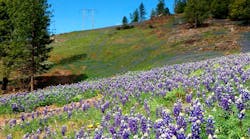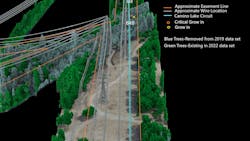Sacramento Public Utility District (SMUD) manages 478 circuit miles of electric transmission lines traversing about 200 miles of right-of-way (ROW) in California. As the sixth largest publicly owned utility in the United States, SMUD is one of only seven North American utilities recognized as a ROW Steward for its sustainable integrated vegetation management (IVM) of electric transmission ROW systems.
The Right-of-Way Stewardship Council (ROWSC) recently recognized the utility with re-accreditation following a rigorous evaluation and audit process completed in December 2022. SMUD is only the third utility to achieve re-accreditation. Along with SMUD, the ROWSC currently recognizes the following other accredited utilities: AltaLink; Arizona Public Service (APS); Bonneville Power Administration (BPA); FirstEnergy; New York Power Authority (NYPA) and Vermont Electric Company (VELCO). One of the benefits to utilities participating in the program is to optimize implementation of IVM principles through feedback from industry experts/auditors during the accreditation assessment.
Investing in IVM
SMUD’s vegetation management program primarily covers two areas: Eldorado County, where SMUD operates its Upper American River Hydroelectric Project, and Sacramento County. The vegetation management program recently established a collaboration with the USDA Forest Service, which supports both risk reduction and forest health at a landscape-level execution.
Back in 2015, the ROWSC first recognized SMUD for its IVM program. Based on regular annual desk reviews and a mid-cycle field review, the council has continued the gold standard recognition. The ROWSC, formed in 2013, established rigorous management gold standards or best management practices (BMP) based on a set of predetermined principles. It requires a formal application process and enlists third-party auditors to ensure demonstrated compliance with the standards.
The ROWSC Accreditation Standards for Assessing Integrated Vegetation Management (IVM) Excellence establish the technical requirements for applicants seeking ROWSC accreditation. The standards are applied in an independent audit of an applicant’s IVM program to aid in identifying excellence. Third-party recognition from industry subject matter experts ensures an independent, proven process to convey credibility and bring recognition to IVM programs.
ROWSC has established top-tier management standards based on 10 principles and 35 criteria points that codify IVM, emphasizing Environmental Social & Governance performance. These principles address compliance with laws, standards, superior practices and BMPs; tenure and use rights and responsibilities; community relations; management planning; understanding pest and ecosystem dynamics; establishing tolerance levels; compilation of an array of vegetation maintenance techniques; accounting for economic and ecological effects of treatments; site-specific implementation of treatments; and monitoring and adaptive management.
Specific highlights from SMUD’s ROWSC re-accreditation audit included SMUD’s support of high-profile local civic activities, including the Community Shade Program and partnership with The Sacramento Tree Foundation. Through this program, the utility has partnered to plant more than 600,000 trees and expanded its offerings to maximize carbon sequestration. The utility also has an active partnership with Sacramento County Parks & American River Parkway Foundation to improve wildlife, reduce noxious weeds and develop pollinator habitat.
Leveraging Technology
SMUD has been leading collaborative problem solving for vegetation management with innovative technology. By effectively using remote sensing technology like LiDAR, imagery and analytics, SMUD can provide laser-focused outcomes for the purpose of risk reduction.
The advanced unique use of technology has allowed SMUD to establish baseline conditions along ROW and geospatially quantify all risks across the system. This has provided comprehensive and effective risk reduction strategies. SMUD’s holistic and targeted IVM approach contributes to improved wildlife and habitat results, and overall environmental stewardship benefits because treatments are more consistent and better
informed by baseline data.
While the use of remote sensing technology may no longer be considered cutting-edge, SMUD’s application, analytics and unique application/approach has included applying the technology outside the ROW to expand easement risk reduction and forest health work on private, federal and private industrial timberlands. This extension of the technology is unique among utilities and an innovative part of SMUD’s IVM leadership contributing to their ROWSC accreditation. The use of technology in this way has strengthened SMUD partnerships with private, industrial timberland owners and federal landowners.
Through these partnerships, diverse landowners and managers are working collaboratively at the landscape and watershed levels on forest health projects. These efforts provide multiple environmental and social benefits with improved forest conditions, less community disruption and improved safety conditions. The innovative and collaborative partnerships that SMUD has developed through the shared use of advanced technology also leverages labor and programmatic costs.
ROW Research
The advantages of IVM have been demonstrated across many uses, including public safety, operational risks, recreational use, public nuisance, site disturbance, water quality, compatible and incompatible vegetation and a range of wildlife species, according to The Cost Efficiency of IVM by John Goodfellow of BioCompliance Consulting. Research has established a preliminary business case for IVM on electric transmission ROW by applying least-cost economic analysis methods focusing exclusively on the direct cost to the utility for vegetation maintenance work practices. That approach limited consideration of the benefits of IVM compared to simply avoided cost. However, indirect costs and benefits of IVM are important considerations.
About 450,000 miles of electric transmission lines operate at 35 kV to 765 kV across North America, with a total land area managed as electric transmission ROW estimated between 9 million to 11 million acres. An additional 306,000 miles of natural gas and liquid petroleum pipeline represents an estimated 2 million acres of land in North America. Reluctance by some vegetation managers to adopt IVM is often based on the perception that it is more expensive when compared
to controlling brush by repeated mowing or just applying traditional methods in a linear fashion.
IVM-based ROW maintenance programs are intended to create, promote and conserve stable native diverse plant communities. A variety of vegetation maintenance methods and combinations of techniques are used to promote sustainable plant communities compatible with the
intended use of the site, and to control, discourage or prevent the establishment of incompatible plants that may create a variety of risks. Industry standard ANSI A300 Part 7 (2019) and ISA BMP, Integrated Vegetation Management 3rd Edition (2019), define IVM on utility ROW. The ROW Stewardship Council’s IVM 2016 Accreditation Requirements define IVM principles and practices for ROW in detail.
A research effort completed in 2019 expanded the evaluation of IVM outcomes to include the development of an enhanced least-cost analysis model and consideration of the many benefits of IVM on electric and gas utility ROW. The figure below (Susie, include the chart from Goodfellow) shows a 20-year cost comparison of mechanical mowing-only treatments v. IVM treatments. The figure shows that, because of the added cost of herbicide treatment during initial clearing, the IVM strategy is initially the higher. At the time of the first maintenance event (four years), the cost of mechanical maintenance overtakes that of the IVM and is double the IVM cost after 20 years. The findings of the research presented a holistic assessment that includes economic considerations, societal implications and environmental externalities associated with IVM. In doing so, it established IVM as the least-costly and most beneficial ROW vegetation management strategy.
ROWSC accreditation provides IVM practitioners in the utility sector with direct and indirect benefits associated with the adoption of an IVM-based strategy. Through this approach, utility companies demonstrate their commitment to environmental stewardship, environmental, social and governance (ESG) principles and the communities they serve. Accredited utilities maintain and sustain power system reliability while enhancing environmental stewardship. ROWSC principles guide member utilities in implementing and continually improving their vegetation management practices.
ROWSC accreditation holds value to the public. ROWSC standards help to foster more comprehensive strategic communication, education and engagement with the public and internal and external stakeholders. ROWSC accreditation provides assurance to regulatory agencies that IVM practitioners meet the program’s rigorous principles while potentially reducing the need for new regulation. This has the potential to improve relations with state and federal agencies. ROWSC principles emphasize methods that reduce incompatible vegetation and establish a sustainable plant community, which can reduce costs of treatment efforts for utilities.
Eric Brown ([email protected]) is T&D manager grid assets – vegetation management for Sacramento Municipal Utility District.





